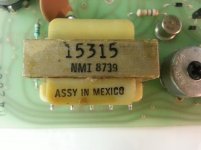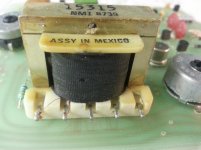This transformer is the output driver transformer. Split common primary and independent secondaries.
Take a look at the schematic Download the Altec Lansing 1590-E service manual for free - Hifi Manuals
Take a look at the schematic Download the Altec Lansing 1590-E service manual for free - Hifi Manuals
Yes but I need more information on number of turns, impedance, etc. so I was hoping to identify the manufacturer and part number.
Altec made it.
You can empirically determine the turns ratio and so the impedance ratio. Insert an AC voltage on one of the windings and measure the voltage on the others.
Number of turns might be estimated by determining the gauge of the wire properly and then using a Kelvin connected meter to find the DCR and figure the resistance per unit length to get an answer.
I think I asked in another thread, but why are you going to this length on an old design like this??
You can empirically determine the turns ratio and so the impedance ratio. Insert an AC voltage on one of the windings and measure the voltage on the others.
Number of turns might be estimated by determining the gauge of the wire properly and then using a Kelvin connected meter to find the DCR and figure the resistance per unit length to get an answer.
I think I asked in another thread, but why are you going to this length on an old design like this??
Last edited:
I am very determined.
I was hoping that I could find a similar performing transformer instead of having to make my own measurements to get a custom...
I was hoping that I could find a similar performing transformer instead of having to make my own measurements to get a custom...
You can buy them used on ebay for as little as $100!
Or a 1594a/b which is slightly lower in power
Besides the circuit is really not so great. There is merit to the output iron, but not in that circuit! The amp was designed at a time when there were no high power complementary devices. So for PA/SR work, was useful to use an output transformer for reliability and to drive "70v" commercial systems.
Perhaps if you would share more about your ultimate goals with this amp I could help you out??
_-_-
PS. junk box scraps, or scrapped 1590 chassis?? Big difference.
Or a 1594a/b which is slightly lower in power
Besides the circuit is really not so great. There is merit to the output iron, but not in that circuit! The amp was designed at a time when there were no high power complementary devices. So for PA/SR work, was useful to use an output transformer for reliability and to drive "70v" commercial systems.
Perhaps if you would share more about your ultimate goals with this amp I could help you out??
_-_-
PS. junk box scraps, or scrapped 1590 chassis?? Big difference.
Yes, the frequency response and stability does leave a lot to be desired.You can buy them used on ebay for as little as $100!
Or a 1594a/b which is slightly lower in power
Besides the circuit is really not so great. There is merit to the output iron, but not in that circuit! The amp was designed at a time when there were no high power complementary devices. So for PA/SR work, was useful to use an output transformer for reliability and to drive "70v" commercial systems.
Perhaps if you would share more about your ultimate goals with this amp I could help you out??
_-_-
PS. junk box scraps, or scrapped 1590 chassis?? Big difference.
Why not model on an Amercron DC500 now that uses normal technology but belt and braces plus an excellent design with a frequency response of DC to 22kHZ +-2dB
Last edited:
- Status
- Not open for further replies.
- Home
- Design & Build
- Parts
- Unidentified Audio Transformer

